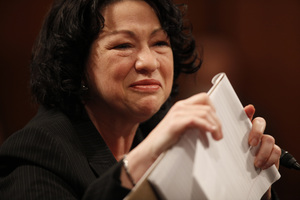Sonia Sotomayor is the first Hispanic and the third female justice to serve on the U.S. Supreme Court. Hailing from a working-class background, Sotomayor brings the real-world experience of a “wise Latina” to the high court.
Sonia Sotomayor’s Early Days
Sonia Maria Sotomayor was born on June 25, 1954, in the Bronx, New York, to Juan and Celina Sotomayor, who had moved to the city from Puerto Rico. Sonia had to deal with difficult circumstances from a very early age; she developed diabetes when she was only 8 years old, and her father, a factory worker who didn’t speak English, died when she was 9. Sonia’s mother, a nurse, worked two jobs in order to support her two children and provide them with an education.
According to NPR, Sonia grew up in a mostly Hispanic neighborhood and never felt like a minority. She describes herself as a “Nuyorican”—a blend of the words “New York” and “Puerto Rican”—to incorporate her Hispanic heritage into her American upbringing.
Sotomayor’s interest for the law sprouted during her childhood, inspired by Nancy Drew novels and the TV show “Perry Mason.” “I was going to college and I was going to become an attorney, and I knew that when I was 10,” Sotomayor told the New York Daily News in 1998. “Ten. That’s no jest.”
Sources in this Story
- U.S. Supreme Court: Biographies of Current Justices of the Supreme Court
- WABC-TV (New York): Judge Sonia Sotomayor bio
- NPR: Sotomayor Shaped By Her ‘Nuyorican’ Roots
- New York Daily News: Bronx judge Sonia Sotomayor would be first Latina on Supreme Court if she replaces Justice Souter
- Newsweek: The Education of Sonia Sotomayor
- Los Angeles Times: Key Ruling Comes From Heart of a Fan
- The New York Times: Sotomayor Confirmed by Senate, 68-31
- New York Daily News: Sonia Sotomayor pays emotional tribute to her mother
Sotomayor’s Judicial Career
Sotomayor completed her undergraduate studies at Princeton University on a scholarship, and graduated summa cum laude and Phi Beta Kappa. Although Sotomayor enjoyed her years as an undergraduate, and is grateful for the world-class education she received and the interesting people she met at Princeton, the subtle elitism that dominated the university’s social sphere made increasingly aware of her ethnic background and pushed her to assert herself against racial biases, Evan Thomas writes in Newsweek.
After Princeton, Sotomayor continued her studies at Yale Law School, and after graduating she spent the next seven years working in public service, both as a prosecutor and private attorney. In 1991, President George H.W. Bush appointed Sotomayor as a federal judge, making her the youngest judge in the district and the first Hispanic federal judge in New York. In 1997, President Bill Clinton chose her as judge for the U.S. Court of Appeals for the Second Circuit.
During her years as a federal judge, Sotomayor made a series of rulings that are considered pivotal in her career. In 1995, she helped put an end to a strike among Major League Baseball players by issuing an injunction against baseball team owners.
Claiming to be an avid baseball fan, Sotomayor used a sports metaphor to describe her crucial ruling, comparing it to the moment “when you see an outfielder backpedaling and jumping up to the wall and time stops for an instant as he jumps up and you finally figure out whether it’s a home run, a double or a single off the wall or an out.”
Supreme Court Nomination
On May 26, 2009, President Barack Obama nominated Sotomayor to replace retiring Justice David Souter on the Supreme Court of the United States. Three months later, she was confirmed by the Senate in a 68-31 vote.
“With this historic vote, the Senate has affirmed that Judge Sotomayor has the intellect, the temperament, the history, the integrity and the independence of mind to ably serve on our nation’s highest court,” declared President Obama.
In spite of her successful career as a lawyer and a judge, and the potential elevation to a position on the High Court, Sotomayor remains genuine and down to earth. In her spare time, she participates in teaching programs for inner-city children, and she remains very close to her mother and extended family.
As Jon O. Newman, senior judge on the 2nd U.S. Circuit Court of Appeals, told WABC-TV, “She’s overcome adversity growing up and made herself an enormous success based on talent and strength of character. And that’s the American dream.”
This article was originally written by Anita Gutierrez-Folch; it was updated May 23, 2017.











